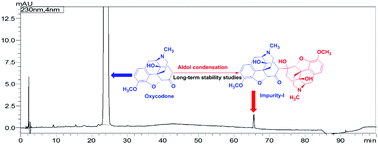Structural elucidation and synthesis of a dimeric degradation impurity during long-term stability studies of oxycodone hydrochloride injection†
Abstract
Oxycodone is one of the most prescribed narcotic medications for the treatment of moderate to severe pain in clinical practice. During long-term stability studies of oxycodone hydrochloride for injection performed as per ICH Q1A (R2) guidelines, an unknown degradation product, impurity-I, increased over time and reached a level of 0.21% after 24 months, based on the results of HPLC analysis. The observed impurity was preliminarily characterized as an oxycodone aldol dimer by using two-dimensional (2D) liquid chromatography (LC) coupled with quadrupole time-of-flight mass spectrometry (QTOF MS/MS) analysis. Impurity-I was synthesized and its molecular structure confirmed based on detailed analysis of 1D-NMR (1H, 13C, and DEPT) and 2D-NMR (1H–1H COSY, HSQC, and HMBC) spectroscopy data. The plausible mechanism for the formation of impurity-I was an aldol condensation reaction under weakly acidic conditions. In addition, the potential toxicity of impurity-I was assessed by in silico toxicity predictions using the TOPKAT software.



 Please wait while we load your content...
Please wait while we load your content...